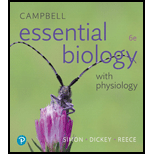
Concept introduction:
Immune system of the human body is divided into two main branches namely the innate immunity and the adaptive immunity. Innate or the body’s first defense mechanism is present since birth, and this defense mechanism is non-specific, which means that it acts as a barrier in for every foreign body irrespective of its structure. Adaptive immunity of the body comes in later stages, when the body is introduced to pathogens. It is a specific type of defense mechanism. The adaptive immune system or the acquired immune system is a subsystem of all immune systems that is the association of highly specialized systematic cells. Adaptive immunity influences immunological memory after an initial response toward a specific pathogen.
Answer to Problem 1SQ
Correct answer: Molecules that elicit a response from lymphocytes are called antigens. Proteins secreted by lymphocytes that bind to these molecules are antibodies.
Explanation of Solution
Antigens:
In immunity of the body, an antigen is a molecule able to trigger an immune response in the body. Antigen is a substance that the immune system perceives as being a foreign material. Any molecule in the immune system that is able to extract an adaptive immune response is referred to as an antigen. In most of the cases, such responses are seen to the nontoxic foreign molecules, such as a foreign protein. The lymphocytes recognize and respond to the specific invading pathogens. Most of the antigens are surface molecules of many viruses or foreign cells.
Antibodies:
In immune systems of the body, antibody is a protein molecule that is produced to deal with invaders, such as microbes and bacteria. It is a blood protein that counteracts the responses to specific antigens.
Lymphocyte carries adaptive immune responses. There are two classes of immune responses seen in lymphocytes, one is antibody-mediated response and the other is cell-mediated response, which is carried out by two different classes of lymphocytes namely B cells and T cells, respectively. In antibody responses, B cells are stimulated to emit antibodies; these proteins are called as immunoglobulin. These antibodies travel throughout the bloodstream and activate the other body fluids, where they attach particularly with the foreign antigens that initiate their production.
Want to see more full solutions like this?
Chapter 24 Solutions
Campbell Essential Biology with Physiology (6th Edition)
- Describe the principle of homeostasis.arrow_forwardExplain how the hormones of the glands listed below travel around the body to target organs and tissues : Pituitary gland Hypothalamus Thyroid Parathyroid Adrenal Pineal Pancreas(islets of langerhans) Gonads (testes and ovaries) Placentaarrow_forwardWhat are the functions of the hormones produced in the glands listed below: Pituitary gland Hypothalamus Thyroid Parathyroid Adrenal Pineal Pancreas(islets of langerhans) Gonads (testes and ovaries) Placentaarrow_forward
- Describe the hormones produced in the glands listed below: Pituitary gland Hypothalamus Thyroid Parathyroid Adrenal Pineal Pancreas(islets of langerhans) Gonads (testes and ovaries) Placentaarrow_forwardPlease help me calculate drug dosage from the following information: Patient weight: 35 pounds, so 15.9 kilograms (got this by dividing 35 pounds by 2.2 kilograms) Drug dose: 0.05mg/kg Drug concentration: 2mg/mLarrow_forwardA 25-year-old woman presents to the emergency department with a 2-day history of fever, chills, severe headache, and confusion. She recently returned from a trip to sub-Saharan Africa, where she did not take malaria prophylaxis. On examination, she is febrile (39.8°C/103.6°F) and hypotensive. Laboratory studies reveal hemoglobin of 8.0 g/dL, platelet count of 50,000/μL, and evidence of hemoglobinuria. A peripheral blood smear shows ring forms and banana-shaped gametocytes. Which of the following Plasmodium species is most likely responsible for her severe symptoms? A. Plasmodium vivax B. Plasmodium ovale C. Plasmodium malariae D. Plasmodium falciparumarrow_forward
- please fill in missing parts , thank youarrow_forwardplease draw in the answers, thank youarrow_forwarda. On this first grid, assume that the DNA and RNA templates are read left to right. DNA DNA mRNA codon tRNA anticodon polypeptide _strand strand C с A T G A U G C A TRP b. Now do this AGAIN assuming that the DNA and RNA templates are read right to left. DNA DNA strand strand C mRNA codon tRNA anticodon polypeptide 0 A T G A U G с A TRParrow_forward
 Human Biology (MindTap Course List)BiologyISBN:9781305112100Author:Cecie Starr, Beverly McMillanPublisher:Cengage Learning
Human Biology (MindTap Course List)BiologyISBN:9781305112100Author:Cecie Starr, Beverly McMillanPublisher:Cengage Learning Human Physiology: From Cells to Systems (MindTap ...BiologyISBN:9781285866932Author:Lauralee SherwoodPublisher:Cengage Learning
Human Physiology: From Cells to Systems (MindTap ...BiologyISBN:9781285866932Author:Lauralee SherwoodPublisher:Cengage Learning Human Heredity: Principles and Issues (MindTap Co...BiologyISBN:9781305251052Author:Michael CummingsPublisher:Cengage Learning
Human Heredity: Principles and Issues (MindTap Co...BiologyISBN:9781305251052Author:Michael CummingsPublisher:Cengage Learning Medical Terminology for Health Professions, Spira...Health & NutritionISBN:9781305634350Author:Ann Ehrlich, Carol L. Schroeder, Laura Ehrlich, Katrina A. SchroederPublisher:Cengage Learning
Medical Terminology for Health Professions, Spira...Health & NutritionISBN:9781305634350Author:Ann Ehrlich, Carol L. Schroeder, Laura Ehrlich, Katrina A. SchroederPublisher:Cengage Learning





